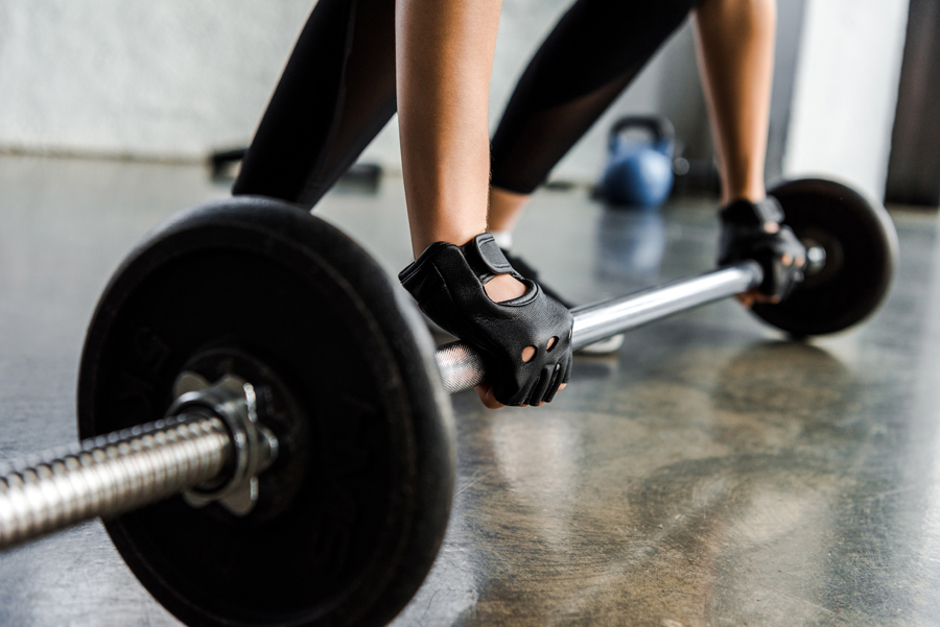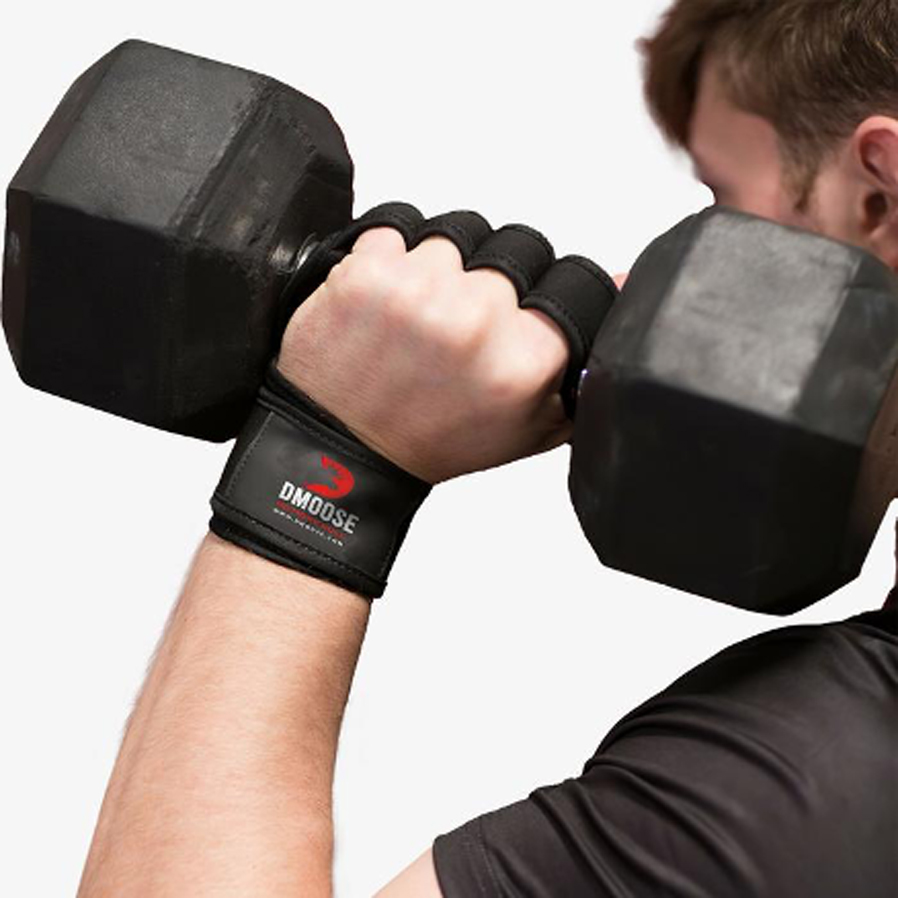
What are Weightlifting Gloves?

Weightlifting gloves are specially designed gloves that are made with leather and wrist support. The leather makes the gloves breathable and prevents the palms from sweating. At the same time, the added wrist support strengthens the forearm and wrist muscles, allowing the lifters to use heavier weights and break through the growth plateaus without risking injuries.
Benefits of Weightlifting Gloves
Do you look at other people in the gym, wearing gloves and lifting heavy weights easily? Do you think the gloves are giving them some edge?
If you nodded yes to the above questions, let me tell you what more benefits these lifters enjoy with these gloves.
1. Provides Finger Protection
If you’re new to weightlifting, then your fingers must not be used to lifting, and consequently at a higher risk of tendon inflammation.
When lifting heavy weights, the fingers take the brunt of the force and stress the tendons, which causes pain, swelling, and even difficulty in bending fingers.
Weightlifting gloves act as a barrier between the weights and your fingers, providing extra support and comfort, so you can avoid stressing joints and gradually increase the loads.
2. Decreased Calluses
Weightlifting means training with heavy weights daily. This daily friction between the bars and the skin causes the lifter’s hands to develop dry hard patches called calluses.
To avoid calluses from getting ripped and painful, wearing weight lifting gloves is extremely important. These gloves provide ventilated cushioning for the fingers so you can lift heavy weights without sweating or getting bruised.
3. Eliminates The Need for Chalk
Using gym chalks is also one of the options available to the lifters when it comes to getting rid of sweaty palms. Unfortunately, gym chalks are not a very friendly option.
Many people are sensitive when breathing around chalk dust and start sneezing and coughing when exposed to the chalk particles. Apart from this, many gyms prohibit chalks as it easily wears off and does not provide stability needed to lift heavy weights; in fact, they create a lot of mess.
This is why wearing weightlifting gloves is the best option. It’s mess-free, breathable, and most importantly, it gives you the ultimate support to lift heavier weights without fearing injuries or weight-dropping accidents.
4. Enhanced Stability
When lifting heavy weights, hand stability is of utmost importance. Stabilizing forearms and hands leads to increased strength, improved muscular endurance, and improved grip strength.
Wearing weightlifting gloves provides a thin and stable platform to lift weights easily. At the same time, the extended wrist support ensures your forearm, wrists, and hands are protected against any injuries so that you can lift for extended training hours comfortably.
5. Improved Work out Technique
Weightlifting exercises are not an easy task and require serious mind and muscle connection, or else the chances of injuries and accidents increase drastically.
Wearing weight lifting gloves allows you to get rid of all your worries, such as sweaty palms, calluses, previous injuries, etc. These gloves allow you to stay mentally present when exercising and focus solely on the weights you’re lifting, which results in better workout techniques and even better results.
6. Reduced Hand Pains
Having painful hands is one of the worst nightmares for weightlifters. These pains occur when you have a chronic physical condition, and your nerves are overworked, you’ve had a previous injury, etc.
Wearing weightlifting gloves with thin padding allows you to maintain your natural gripping position while providing various movements. Moreover, having non-slip material ensures your hands stay fixed in one place, and you don’t suffer calluses or blisters due to friction.
Who Should Use Weightlifting Gloves?
Anyone who wants to enjoy their weightlifting sessions, such as nsuns, without fearing injuries or weight-dropping accidents must use weightlifting gloves. These gloves are the ultimate way to protect your hands from sweat, bruises, wrist injuries, etc., while supporting and stabilizing your hands and enhancing your grip strength.
These gloves are highly recommended for the new lifters and professionals because the new lifter’s hands and fingers are not used to carrying lots of weight and will have swollen tendons.
On the other hand, the professionals can develop hand pains due to heavy lifting and may even have previous wrist or forearm injuries that they do not want to relive.
Furthermore, every weightlifter wants to lift as heavy loads as possible, and having a poor grip or sweaty palms can come between their lifting dreams and muscular growth. Weightlifting gloves allow the lifters to increase the lifting load gradually, taking them closer to their lifting dream and breaking through the plateaus, one step at a time.
Buyer’s Guide to Weightlifting Gloves
When buying weightlifting gloves, there are a few things that you’d want to keep in mind so you can truly enjoy the weightlifting experience.
- Lifting gloves should always have thin padding at the palm. This thin layer will allow you to maintain your hand’s natural grip while moving it in various directions. This thin layer will help you stabilize the hands and act as a shield between the bars and skin, helping you avoid blisters and calluses.
- Next thing on the list is a strong, firm grip. One of the main reasons for wearing weightlifting gloves is to have a firm, stable grip of the bars, so you don’t end up dropping the weights. Weightlifting gloves should have anti-slip silicone padding on the palms so that you can enjoy a tension-free training session.
- Breathability is also amongst the few important aspects of a weightlifting glove. The gloves must be made with a breathable material so your hands can have proper ventilation when lifting. If the gloves are not sweatproof and breathable, you will get blisters and calluses due to moisture retention.
- Lastly, the wrist support and stitching of the gloves should be of the highest quality so that your gloves don’t end up tearing apart after a few rough lifting sessions. The wrist support will help stabilize your hands, forearms, and wrists, preventing injuries and allowing you to lift heavy weights easily.
Conclusion
Wearing weightlifting gloves is still a personal choice. They bring the users multiple benefits that no one can deny and help them enjoy the training sessions peacefully.
If these gloves are giving your comfort and helping you reach your goal with added protection against wrist injuries and calluses, why not use them? It’s always better to be safe than sorry.
References:
- Golshani, Kayvon, et al. ‘Upper Extremity Weightlifting Injuries: Diagnosis and Management’. Journal of Orthopaedics, vol. 15, no. 1, Mar. 2018, pp. 24–27. ScienceDirect, https://doi.org/10.1016/j.jor.2017.11.005.
- Levine, Norman. ‘Friction Blisters’. The Physician and Sportsmedicine, vol. 10, no. 3, Mar. 1982, pp. 84–92. Taylor and Francis+NEJM, https://doi.org/10.1080/00913847.1982.11947185.
- Gerbino, Peter G. ‘Wrist Disorders in the Young Athlete’. Operative Techniques in Sports Medicine, vol. 6, no. 4, Oct. 1998, pp. 197–205. ScienceDirect, https://doi.org/10.1016/S1060-1872(98)80003-8.
Comments
comments